ASP.NET Core3.1使用Identity Server4建立Authorization Server
前言
网上关于Identity Server4的资料有挺多的,之前是一直看杨旭老师的,最近项目中有使用到,在使用.NET Core3.1的时候有一些不同。所以在此记录一下。
预备知识: https://www.cnblogs.com/cgzl/p/9405796.html
本文内容参考
如杨旭老师所说,官方文档真的很详细,有时间建议大家看下官方文档。
建立Authorization Server
建立ASP.Net Core项目使用空模板。
项目建立之后,运行方式改为使用控制台运行而不是IIS Express,以便查看各种debug信息。
这个已成为习惯,也是学习杨老师的,确实比较方便,当然如果不喜欢可以不设置,只需要端口号配置的时候对应好就可以的。
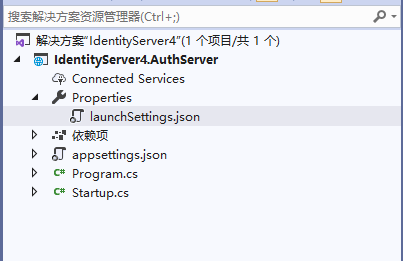
修改后文件代码为:
{
"profiles": {
"IdentityServer4.AuthServer": {
"commandName": "Project",
"launchBrowser": true,
"applicationUrl": "http://localhost:5000",
"environmentVariables": {
"ASPNETCORE_ENVIRONMENT": "Development"
}
}
}
}
端口号为5000,此时运行程序,会显示出Hello World!,默认的,没有修改。

安装Identity Server4

点击安装就好啦。
配置Identity Server4
API和客户端
API的配置和之前有所不同,之前是
ApiResources,现在分为ApiResources和ApiScopes,后续会说到。
using IdentityServer4.Models;
using IdentityServer4.Test;
using System.Collections.Generic;
namespace IdentityServer4.AuthServer.Configuration
{
public class InMemoryConfiguration
{
/// <summary>
/// Api Scopes
/// </summary>
/// <returns></returns>
public static IEnumerable<ApiScope> ApiScopes()
{
return new List<ApiScope>
{
new ApiScope("scope1","scope1")
};
}
/// <summary>
/// ApiResources
/// </summary>
/// <returns></returns>
public static IEnumerable<ApiResource> ApiResources()
{
return new[]
{
new ApiResource
{
Name = "api1",
DisplayName = "My Api1",
Scopes = { "scope1" }
}
};
}
/// <summary>
/// Clients
/// </summary>
/// <returns></returns>
public static IEnumerable<Client> Clients()
{
return new[]
{
new Client
{
ClientId = "client",
AllowedGrantTypes = GrantTypes.ResourceOwnerPasswordAndClientCredentials,
ClientSecrets =
{
new Secret("secret".Sha256())
},
AllowedScopes = { "scope1" }
}
};
}
/// <summary>
/// Users
/// </summary>
/// <returns></returns>
public static IEnumerable<TestUser> Users()
{
return new[]
{
new TestUser
{
SubjectId = "1",
Username = "mail@qq.com",
Password = "password"
}
};
}
}
}
ApiScopes: 这个应该怎么翻译我也不清楚,API范围?如果没理解错的话,就是给之前的ApiResources进行了一个分组。授权的时候会验证Scope。
ApiResources:比如官网的第一个demo,可能会有疑问,你怎么知道我是api1呢?其实,就没有验证,只要有授权码就可以访问的。如果说,我只要api1的话,那就用到ApiResources了,生产环境中,也必然是需要用到的。
加载资源和客户端
修改Startup.cs
public void ConfigureServices(IServiceCollection services)
{
services.AddIdentityServer()
.AddDeveloperSigningCredential()
.AddTestUsers(InMemoryConfiguration.Users().ToList())
.AddInMemoryClients(InMemoryConfiguration.Clients())
.AddInMemoryApiScopes(InMemoryConfiguration.ApiScopes())
.AddInMemoryApiResources(InMemoryConfiguration.ApiResources());
}
当然,也需要app.UseIdentityServer();
首次启动时,Identity Server4将创建一个开发人员签名密钥,该文件名为
tempkey.rsa。不必将该文件签入源代码管理中,如果不存在该文件将被重新创建。也就是AddDeveloperSigningCredential()。 这个方法只适合用于Identity Server4在单个机器运行, 如果是生产环境你得使用AddSigningCredential()这个方法.
运行一下,发现并没有什么改变,不过打开:http://localhost:5000/.well-known/openid-configuration,则应该看到所谓的发现文档。发现文档是身份服务器中的标准端点。客户端和API将使用发现文档来下载必要的配置数据。

获取Token
打开Postman,按照配置的输入然后试一下
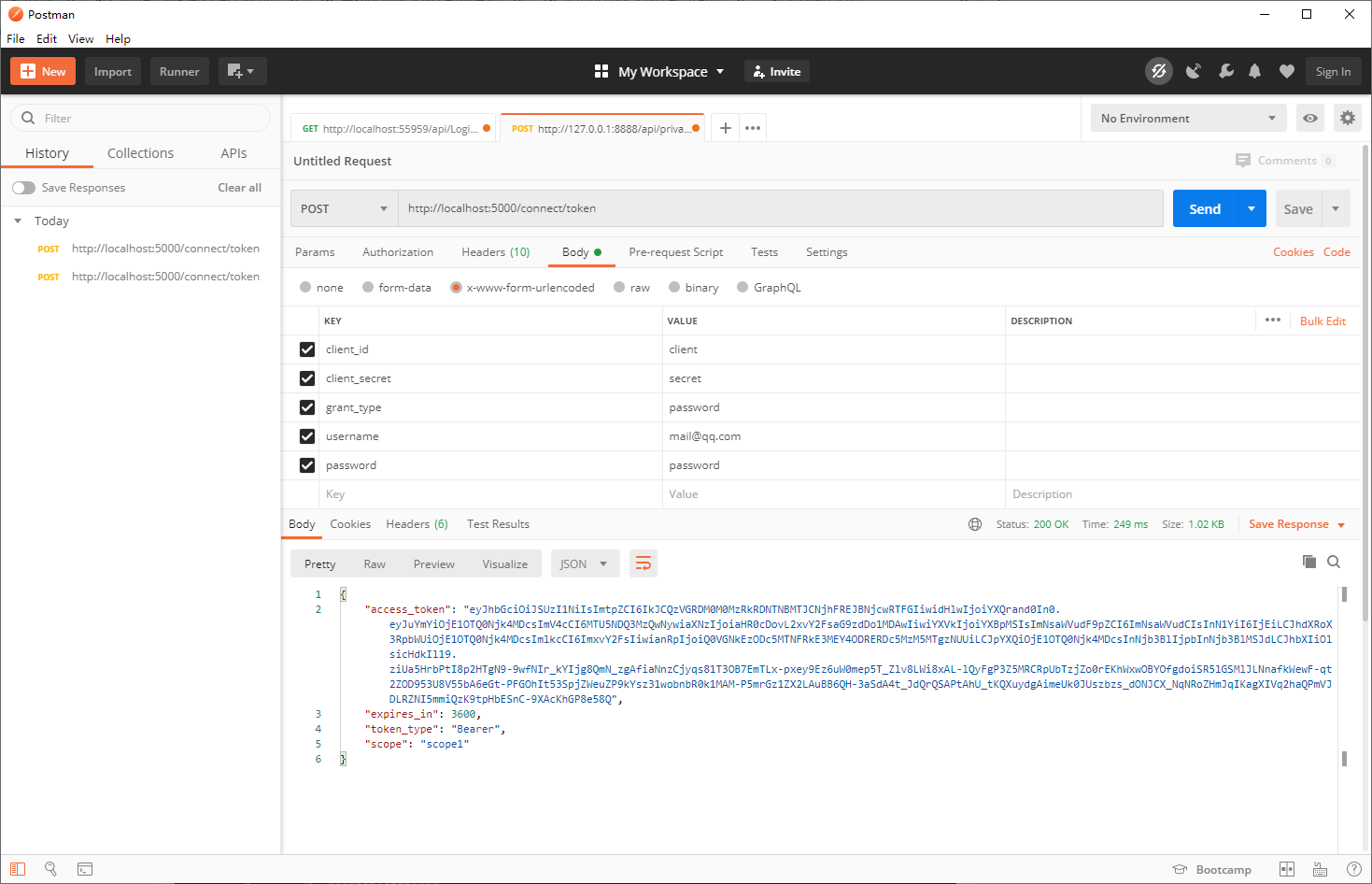
获取到Token,控制台输出如下:
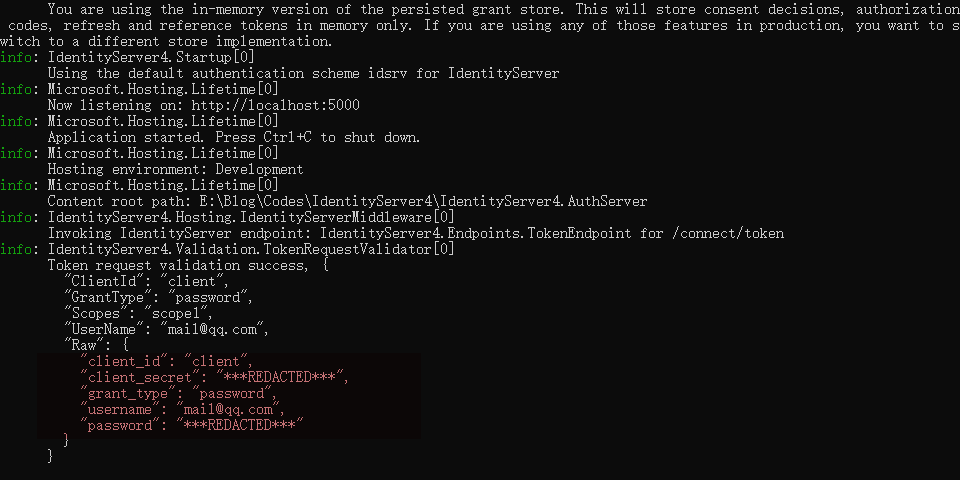
这里是有用户的信息的,但是我们可以把用户信息去掉,然后GrantType改为client_credentials,我们设置的是 ResourceOwnerPasswordAndClientCredentials 这个GrantType,所以使用用户名密码以及使用ClientCredentials都可以。
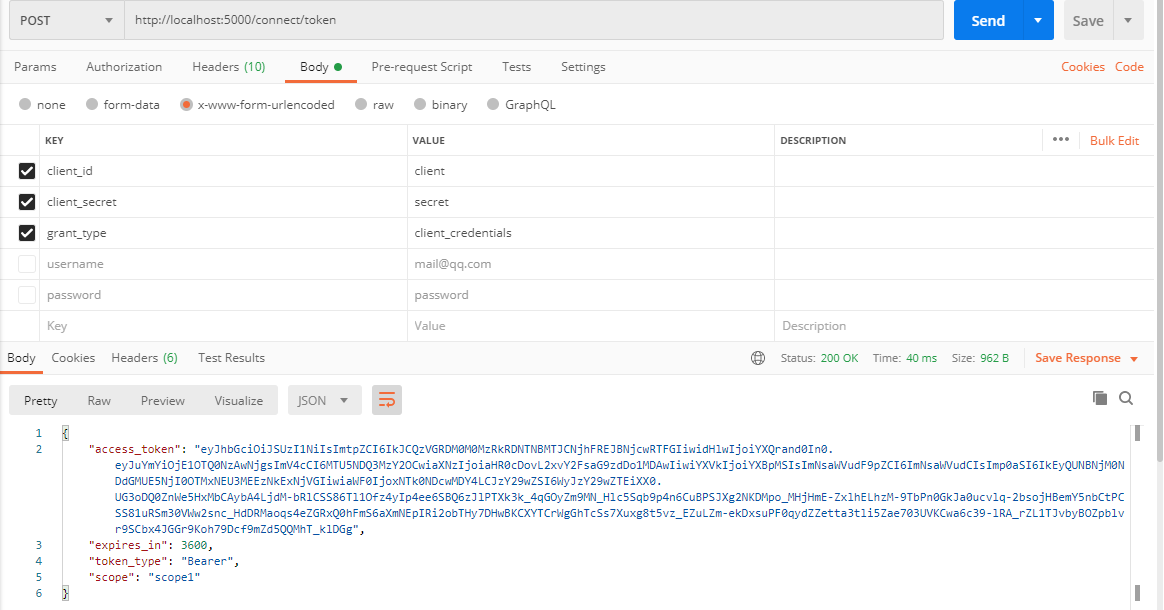
不过此时控制台会有区别,没有用户信息了。

美化美化UI
Identity Server 4 提供了一套QuickStart UI
https://github.com/IdentityServer/IdentityServer4.Quickstart.UI
此存储库包含UI所需的控制器,模型,视图和CSS文件。只需下载/克隆并将其复制到Web项目中即可。
打开项目根目录,运行Powershell,然后输入命令:
iex ((New-Object System.Net.WebClient).DownloadString('https://raw.githubusercontent.com/IdentityServer/IdentityServer4.Quickstart.UI/main/getmain.ps1'))

不过可能你会遇到我前三次那种错误,嗯,访问不了,那就全局或者先下载下来人工粘贴过去吧~
好了以后我们的项目是酱紫的:
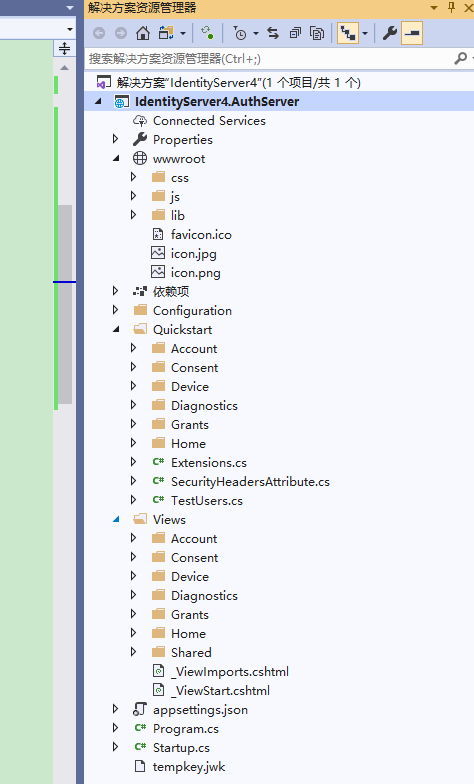
由于有wwwroot下很多静态文件, 所以asp.net core 需要启用服务静态文件的功能: 修改Startup的Configure方法
先看修改前的样子吧
public void Configure(IApplicationBuilder app, IWebHostEnvironment env)
{
if (env.IsDevelopment())
{
app.UseDeveloperExceptionPage();
}
app.UseIdentityServer();
app.UseRouting();
app.UseEndpoints(endpoints =>
{
endpoints.MapGet("/", async context =>
{
await context.Response.WriteAsync("Hello World!");
});
});
}
修改后
public void Configure(IApplicationBuilder app, IWebHostEnvironment env)
{
if (env.IsDevelopment())
{
app.UseDeveloperExceptionPage();
}
app.UseIdentityServer();
app.UseStaticFiles();
app.UseRouting();
app.UseAuthorization();
app.UseEndpoints(endpoints =>
{
endpoints.MapControllerRoute(
name: "default",
pattern: "{controller=Home}/{action=Index}/{id?}"
);
});
}
是不是抛异常了?
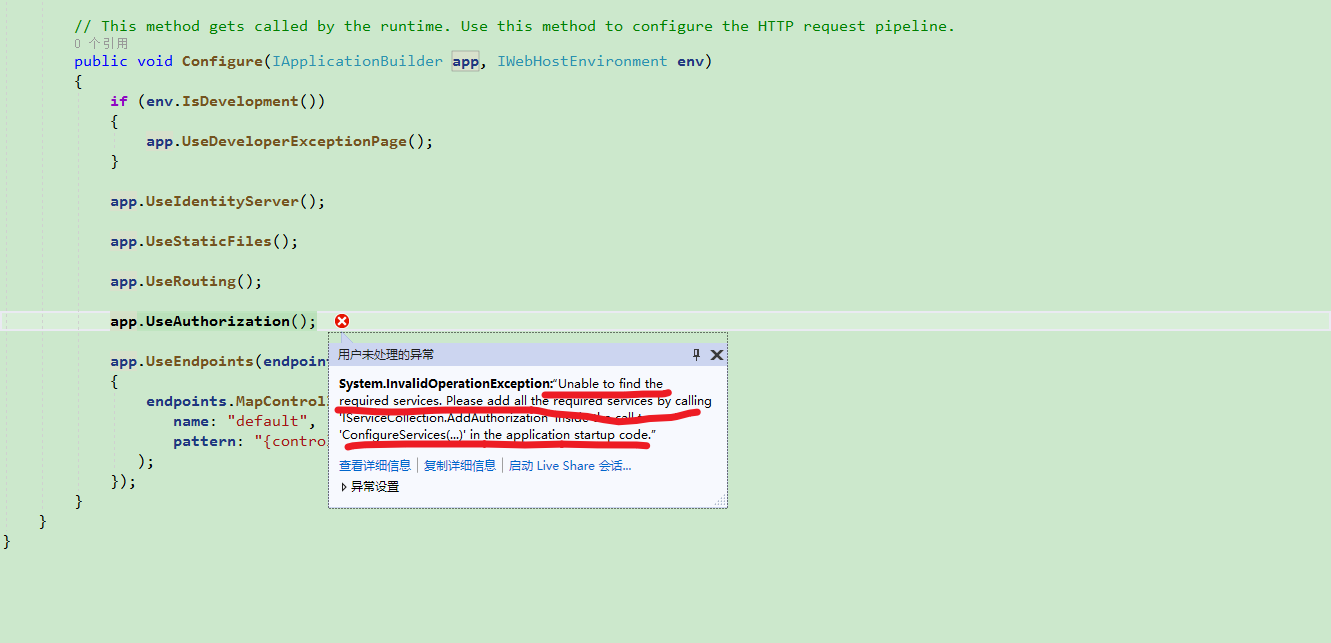
因为我们现在有UI了,所以不要忘记在ConfigureServices里面注册MVC。
public void ConfigureServices(IServiceCollection services)
{
services.AddControllersWithViews();
services.AddIdentityServer()
.AddDeveloperSigningCredential()
.AddTestUsers(InMemoryConfiguration.Users().ToList())
.AddInMemoryClients(InMemoryConfiguration.Clients())
.AddInMemoryApiScopes(InMemoryConfiguration.ApiScopes())
.AddInMemoryApiResources(InMemoryConfiguration.ApiResources());
}
然后运行一下试试:
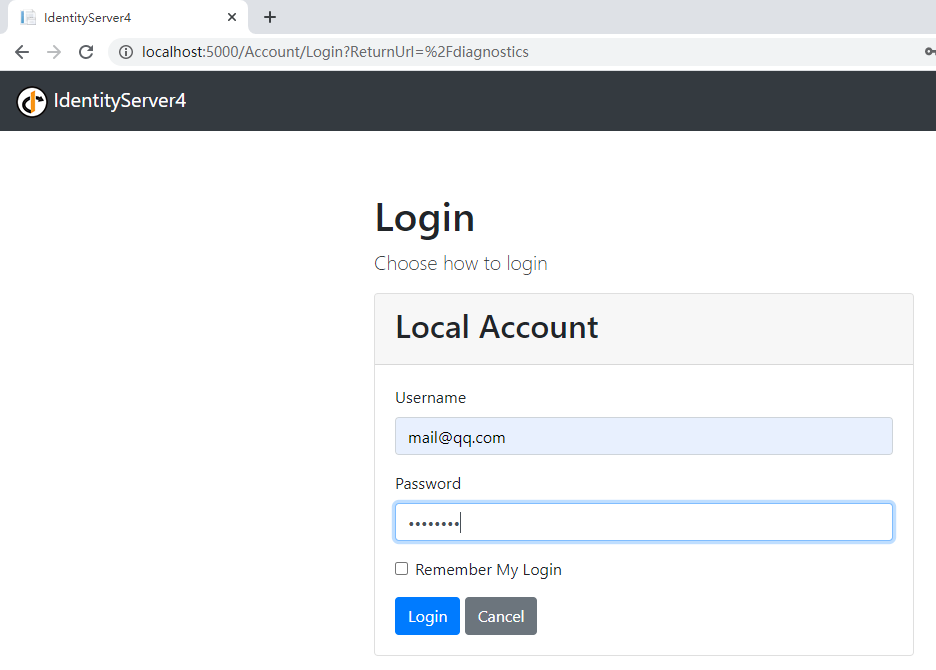
登录一下~
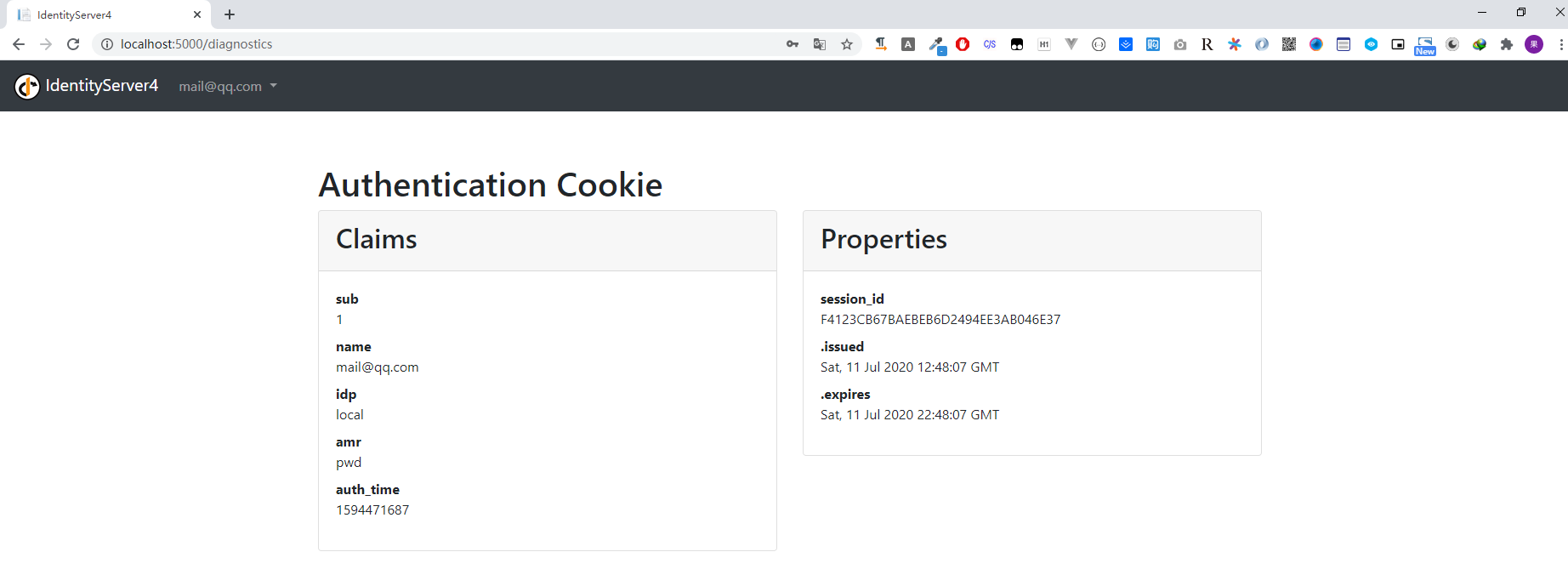
好了,现在我们已经可以登录成功了。
登录界面可以自定义的~,OK,今天就到这里
计划
接下来会说一下
- 建立我们的API项目并使用Token测试接口
- 建立一个MVC客户端项目访问我们的API
- 建立一个JS(Vue)客户端访问我们的API项目
End
推广下自己的公众号一个逗逼的程序员,主要记录自己工作中解决问题的思路分享及学习过程中的笔记。绝对不会程序员贩卖程序员的焦虑来割韭菜。

ASP.NET Core3.1使用Identity Server4建立Authorization Server的更多相关文章
- ASP.NET Core3.1使用Identity Server4建立Authorization Server-2
前言 建立Web Api项目 在同一个解决方案下建立一个Web Api项目IdentityServer4.WebApi,然后修改Web Api的launchSettings.json.参考第一节,当然 ...
- 从头编写asp.net core 2.0 web api 基础框架 (5) + 使用Identity Server 4建立Authorization Server (7) 可运行前后台源码
前台使用angular 5, 后台是asp.net core 2.0 web api + identity server 4. 从头编写asp.net core 2.0 web api 基础框架: 第 ...
- 使用Identity Server 4建立Authorization Server (1)
预备知识: http://www.cnblogs.com/cgzl/p/7746496.html 本文内容基本完全来自于Identity Server 4官方文档: https://identitys ...
- 使用Identity Server 4建立Authorization Server
使用Identity Server 4建立Authorization Server (6) - js(angular5) 客户端 摘要: 预备知识: http://www.cnblogs.com/cg ...
- 三、IDS4建立authorization server
建立authorization server 一.环境搭建 1.创建项目 2.引用NuGet的identityserver4 3.配置asp.net core 管道 打开Startup.cs, 编辑C ...
- 使用Identity Server 4建立Authorization Server (3)
预备知识: http://www.cnblogs.com/cgzl/p/7746496.html 第一部分: http://www.cnblogs.com/cgzl/p/7780559.html 第二 ...
- 使用Identity Server 4建立Authorization Server (5)
预备知识: http://www.cnblogs.com/cgzl/p/7746496.html 第一部分: http://www.cnblogs.com/cgzl/p/7780559.html 第二 ...
- 使用Identity Server 4建立Authorization Server (6) - js(angular5) 客户端
预备知识: http://www.cnblogs.com/cgzl/p/7746496.html 第一部分: http://www.cnblogs.com/cgzl/p/7780559.html 第二 ...
- 使用Identity Server 4建立Authorization Server (2)
第一部分: http://www.cnblogs.com/cgzl/p/7780559.html 第一部分主要是建立了一个简单的Identity Server. 接下来继续: 建立Web Api项目 ...
随机推荐
- 其他函数-web_get_int_property
用于记录http响应的信息.这个函数在调试脚本的常用,但是在实际压力测试中请将这些注释 使用这个函数可以获取到的信息有: 1.HTTP_INFO_RETURN_CODE:返回HTTP响应码 2.HTT ...
- 在android项目中使用FontAwesome字体
在android项目中使用FontAweSome图标集,可以方便的适配各种屏幕分辨率,不必在各种不同分辨率文件夹中新建资源文件.使用字体是一种很巧妙的方法,把图像以字体的方式呈现,这样以前设置为and ...
- linux下操作memcache的操作命令
1.连接memcache linux下一般使用telnet连接memcache服务 [root@localhost ~]# telnet 127.0.0.1 11266 Trying 127.0.0. ...
- 面试问Redis集群,被虐的不行了......
哨兵主要针对单节点故障无法自动恢复的解决方案,集群主要针对单节点容量.并发问题.线性可扩展性的解决方案.本文使用官方提供的redis cluster.文末有你们想要的设置ssh背景哦! 本文主要围绕如 ...
- Wireshark论证TCP3次握手的过程
wireshark过滤条件:ip.addr == 120.79.36.180 千万别写成 ip.dst == 120.79.36.180 ,这样子就看不到服务器给我们返回的包了 此时,在浏览器输入12 ...
- [ C++ ] 勿在浮沙筑高台 —— 内存管理(1~8p)primitives(上)
C++ memory primitives(原语) new 若malloc失败会调用 int _callnewh(size_t t); 即调用用户设定的handler(回调函数指针),可用于内存回收防 ...
- 1.尚硅谷_MyBatis_简介.avi
hibernate旨在消除mysql语句.程序员不写sql语言,要实现复杂的功能需要学习hibernate的hql语句 mybatis把编写sql语言交给程序员,程序员自己在xml控制sql语句的编写 ...
- java面试必备知识点-上中下三篇写的很详细
参考博客:写的还是相当的经典 http://www.cnblogs.com/absfree/p/5568849.html 上中下三篇写的很详细 http://blog.csdn.net/riverfl ...
- RabbitMQ:一、入门
消息中间件 使用消息中间件的作用 解耦 削峰 异步 顺序保证 冗余(存储) RabbitMQ的特点 可靠性 灵活的路由 扩展性 高可用 多语言客户端 插件机制 多协议(主要还是AMQP) 相关概念 P ...
- 4W字的后端面试知识点总结(持续更新)
点赞再看,养成习惯,微信搜索[三太子敖丙]关注这个互联网苟且偷生的工具人. 本文 GitHub https://github.com/JavaFamily 已收录,有一线大厂面试完整考点.资料以及我的 ...
